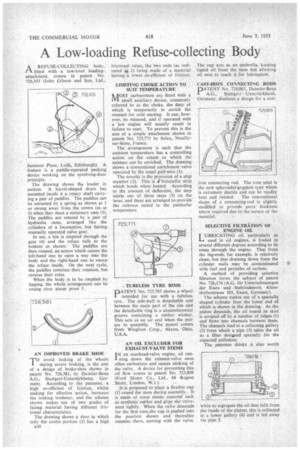A Low-loading Refuse-collecting Body
Page 64

If you've noticed an error in this article please click here to report it so we can fix it.
A REFUSE-COLLECTING body, rt fitted with a low-level loadingattachment, comes in patent No. 726,103 (John Gibson and Son, Ltd., Jameson Place, Leith, Edinburgh). A feature is a paddle-operated packing device working on the revolving-door principle.
The drawing shows the loader in section. A barrel-shaped drum has mounted inside it a rotary shaft carrying a pair of paddles. The paddles can be retracted by a spring as shown at 1 or swung away from the centre (as at 2) when they meet a stationary cam (3). The paddles are rotated by a pair of hydraulic rams, arranged like the cylinders of a locomotive, but having manually operated valve gear.
In use, a bin is emptied through the gate (4) and the refuse falls to the bottom as shown. The paddles are then rotated, an action which causes the left-hand one to open a way into the body and the right-hand one to sweep the refuse inside. On the next cycle, the paddles continue their rotation, but reverse their roles.
When the body is to be emptied by tipping; the whole arrangement can be swung clear about pivot S.
AN 'IMPROVED BRAKE SHOE 1"0 avoid locking of the wheels during severe braking, is the aim of a design of brake-shoe shown in patent No. 726,381, by Daimler-Benz A.G., Stuttgart-Untertfirkheim, Germany. According to the patentee, a high co-efficient of friction, whilst making for effective action, increases the locking tendency, and the scheme shown makes use of two grades of facing material having different frictional characteristics.
The drawing shows a shoe in which only the centre portion (1) has a high B30
frictional value, the two ends (as indi cated 2) being made of a material having a lower co-efficient of friction.
LIMITING CHOKE ACTION TO SUIT TEMPERATURE ft AOST carburetters are fitted with a IVI small auxiliary device, commonly referred to as the choke, the duty of which is temporarily to enrich the mixture for cold starting. It can, however, be misused, and if operated with a hot engine will usually result in failure to start. To prevent this is the aim of a simple attachment shown in patent No. 725,771 by Soles, Neuillysur-Seine, France.
The arrangement is such that the ambient temperature has a controlling action on the extent to which the mixture can be enriched. The drawing shows a conventional enrichment valve operated by the usual pull-wire (1).
The novelty is the provision of a stop member (2). This is k bimetallic strip which bends when heated. According to the amount of deflection, the stop meets one of three steps (3) on the lever, and these are arranged to provide the richness suited to the particular temperature.
TUBELESS TYRE RIMS
PATENT No. 725,767 shows a wheel intended for use with a tubeless tyre. The side-wall is detachable and between the main part of the rim and the detachable ring is a circumferential groove containing a rubber washer. This acts as an air seal when the pair are in assembly. The patent comes from Wingfoot Corp., Akron, Ohio, U.S.A.
AN OIL EXCLUDER FOR EXHAUST-VALVE STEMS I N an overhead-valve engine, oil run
ning down the exhaust-valvestemoften carbonizes and causes sticking of the valve. A device for preventing this oil flow comes in patent No. 725,899 (Ford Motor Co., Ltd., 88 Regent Street, London, W.1.).
It is proposed to place a flexible cup (I) round the stem during assembly. It is made of some elastic material such as synthetic rubber and grips the valvestem tightly. When the valve descends for the first time.the cup is pushed into the position shown and thereafter remains there, moving with the valve. The cup acts as an umbrella, keeping liquid oil from the stem but allowing oil mist to reach it for lubrication.
CAST-IRON CONNECTING RODS
PATENT No. 724.067, Daimler-Benz A.G., Stuttgart Untertfirkheim, Germany, discloses a design for a cast
iron connecting rod. The iron us'ed is the new spheroidal-graphite type which is extremely ductile and can be readily bent and twisted. The conventional shape of a connecting-rod is slightly modified to provide extra thickness where required due to the nature of the material.
SELECTIVE FILTRATION OF ENGINE OIL UBRICATING oil, particularly as used in oil engines, is fouled in several different degrees according to its route through The engine. That from the big-ends, for example, is relatively clean, but that draining down from the cylinder walls may be contaminated with fuel and particles of carbon.
A method of providing selective filtration forms the subject of patent No. 726,176 (A.G. fiir Unternehmungen der Eisen und Stahlindustrie, Altendorferstrasse 103, Essen, Germany).
The scheme makes use of a specially shaped cylinder liner the lower end of which is shown in the drawing. As the piston descends, the oil round its skirt is scraped off by a number of ridges (1) and flows into channels between them. The channels lead to a collecting gallery (2) from which a pipe (3) takes the oil to a filter designed specially for the expected pollution.
The patentee thinks it also worth while to segregate the oil that falls from the inside of the piston; this is collected in a lower gallery (4) and is led away via pipe 5.




































































































